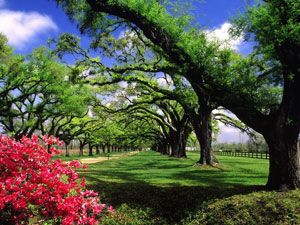 Leaves appear green because green light is reflected back by the chlorophyll, while other wavelengths are absorbed.
Leaves appear green because green light is reflected back by the chlorophyll, while other wavelengths are absorbed.
The receptor in the photosynthesis process consists of hundreds of chlorophyll and carotenoid molecules and the molecule of chlorophyll a, which is the reaction centre.
All substances, except wholly transparent ones, absorb light, and their colors stem from the wavelength of the light they reflect, and which is not absorbed by the surface in question. Chlorophyll, present in all photosynthetic cells and a variety of pigments, absorbs all visible wavelengths of light except green. This reflected light is what makes leaves appear green. Black substances absorb nearly all the light that falls on them. White pigments, on the other hand, reflect nearly all the wavelengths of light that strike them.
For example, the pigments in plants known as chlorophyll permit the color green to appear and are also where photosynthesis takes place. Pigment molecules are formed by atoms such as carbon, hydrogen, magnesium, oxygen and nitrogen combining together. Considering the properties of chlorophyll, which plays a vital role in the continuation of life, will afford a better understanding of the sensitive, delicate calculations on which it is constructed.
Organized in groups of 250 to 400, chlorophyll molecules constitute a structure known as the photosystem, which carries out vital processes. All the chlorophyll molecules within this system can absorb light, but only one chlorophyll molecule in every photosystem actually uses the chemical energy obtained in this way. The molecule using the energy installs itself in the middle of the photosystem. The other chlorophyll molecules are known as antenna pigments, which collect light for the reaction center (that is, “chlorophyll a”) by establishing a network around it. When the reaction center receives energy from one of the more than 250 antennae molecules the energy boosts an electron out of place to a higher energy level. In other words, an electron belonging to the “chlorophyll a” moves to one of the other chlorophyll molecules arranged around it. Thus thanks to a chain reaction an electron exchange, photosynthesis begins. 73Therefore, the organs we call pigments play a vital role in the process of photosynthesis, while these molecules with their very special structure give rise to the green world of plants around us. When the components of the chloroplast are examined, they are seen to be built on very delicate calculations and a highly detailed system. It is Almighty Allah Who disposes such a detailed design into a space too small to be seen with the naked eye.
When the components of the chloroplast are examined, they are seen to be built on very delicate calculations and a highly detailed system. It is Almighty Allah Who disposes such a detailed design into a space too small to be seen with the naked eye.
Upon entering a garden, you see flowers with stunning bright colors and patterns. When we see a red rose, for instance, we enjoy its color without knowing what that rose’s true color actually is. In fact, this “red” color stems from the rose’s pigments reflecting the rays of that particular wavelength. The pigments in the petals reflect only red wavelengths, which we then perceive as that particular color.
TOPICS
VaticanSocialismIlluminationFrench RevolutionConvertSabbateanJacobinismMasonic MediaPolitical ZionismYoung TurkThe Committee of Union and ProgressAbdulhamidAnti-NaziWorld Zionist Organization Nuremberg LawsMussoliniWorld War IAdolf EichmannGoyimThe Rothschild DynastyThink-ThankCFRRockefellerCold WarStalinOctober RevolutionSoviet UnionBilderbergVietnamAIPACLobbyfairSoutheastGreeceNew World OrderRed Seageopoliticsveterantaxcustoms2023antelopebullEurasia Islam CouncilNobel PrizeHospitalSocial Security InstitutionAli BabacanTurgut OzalassassinationGaffar OkkanMuhsin YazıcıoğluRosetta NebulaAstronomyRose


